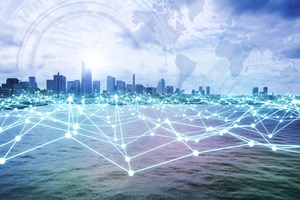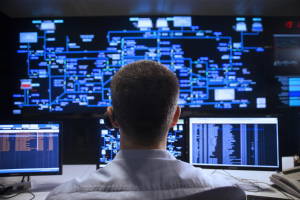Sound water resource management will be essential in the cities of the future. In water-smart cities, digital twins will be instrumental in encouraging more responsible water use thanks to the active role of citizens and the extraction of value from infrastructure information, says Pilar Conejos, digital twin manager, Idrica.
In the water industry, digital twin technology reproduces the real behavior of the distribution network by creating a virtual copy of the physical system. One of its main advantages is the ability to anticipate the network’s response to any circumstance, whether or not it has occurred in the past. It is a useful tool to improve the system’s resilience since it can simulate different real and fictitious scenarios.
Moreover, thanks to the holistic view they provide, digital twins are an excellent platform for making decisions based on more efficient water use, and for boosting cooperation between citizens and utilities.
Their operation is possible thanks to the data or information available in the physical system, so fitting infrastructures with sensors and the implementation of digital systems (SCADAs, GIS, CMMS, smart meters…) is a prerequisite for their deployment.
Nowadays, more and more cities are choosing to generate and collect different types of data such as information related to the concurrence of people in urban spaces, traffic and tourism. All this information can be integrated with infrastructure digital twins to improve the services offered to citizens, including their water supply. In water-smart cities, this technology will be able to combine information not only about the water resource and its infrastructure, but also about any other element that must be taken into account when adapting planning and management to the needs of the population at any given time.

It is important to underscore that a water service is basic in a city, and therefore it must be protected against any eventuality. This requires a resilient system that can adapt to changes. In this sense, digital twins in water-smart cities can cut response times to critical events, such as emergencies, water shortages, health alerts and climate change-related events. By anticipating problems and identifying the measures needed to prevent emergencies or minimise their consequences, they ensure the water supply will be available 24/7, even in critical situations and complex distribution systems.
The fact that new ideas and changes can be tested virtually, before making a decision in the real system, minimises risks, time and costs in water management.
Efficiency is no longer optional; instead it is a mandatory goal in a context of increasing scarcity. Management in water-smart cities will focus on meeting the Sustainable Development Goals set by the UN, thus increasing water security and ensuring access to drinking water and sanitation.
The magnitude of the challenges we are facing is such that we will only be able to tackle them by working together, with citizens playing an active role. The increase in water demand due to urban growth and water scarcity undoubtedly requires the collaboration of water utilities but also of citizens as end users.

Digital twins, thanks to the information they provide, will become a key tool to engage citizens in more responsible water use. Firstly, data about the service and their own domestic consumption will help them to make better decisions and, secondly, to gain first-hand knowledge of the impact of their actions. For example, access to detailed consumption data will lead to better performance and awareness of responsible water use policies.
In addition, digital twins favor two-way communication between citizens and utilities. While the former will be able to report any event they detect in the network so that it can be dealt with as soon as possible, consumers can be notified in advance of possible supply disruptions, whether due to planned operations in the network or an emergency.
This means that citizens go from being mere recipients of information to occupying an active, central role in management. The implementation of technology is fundamental in water-smart cities, although individual participation is essential to continue advancing towards the protection of water resources.
In fact, 21st century citizens are already demanding greater transparency and better service. There is also a clear overall commitment to sustainability in cities. The aim is for them to be able to adapt to climate change through planning, optimum infrastructure management and citizen participation.
To achieve this, it will be imperative to continue to equip water infrastructures with sensors and to make progress in obtaining data from the various municipal services (traffic management, health care, public safety, etc.). However, this is only the first step, since what is really important is to make the information available to those who need it. Water is a basic service, but at the same time it coexists with other services in the city, meaning that there is a need for a holistic planning approach based on data and on the impact of some areas on others.
In water-smart cities, each infrastructure will have its own digital twin. These will be connected to each other, reflecting the impact that some services have on others. Thanks to this holistic, global vision, it will be easier to extract the value of all the information.

In short, it is not just a matter of having the data, but of extracting value from it. Digital twins are seen as tools for providing a cross-cutting view of everything that happens in a city thanks to the integration of information. In order to implement them successfully, infrastructure managers will have to overcome a number of challenges, such as poor data quality and its location in isolated systems that are difficult to connect, and the intrinsic complexity of having a simulation model that needs to be constantly updated and running in real time.
In the next few years, digital twins will not only be an essential part of the management of water distribution systems, but also one of the tools most widely used in cities to address new challenges.
The author is Pilar Conejos, digital twin manager, Idrica.
About the author
Pilar Conejos is a digital twin manager at Idrica. She has a PhD in Industrial Engineering and is a part time assistant professor at the Universitat Politecnica de Valencia, Spain. She has over 20 years of experience in hydraulic engineering and water management. She is the co-author of several technical papers and is an international guest speaker. Formerly the head of network control and regulation for Valencia and its Metropolitan Area at the water utility Global Omnium, she recently joined Idrica as a water consultant expert, bringing a perspective and extensive experience about digital twins and water networks.
Comment on this article below or via Twitter: @IoTNow_OR @jcIoTnow










